Expert Guides
10 Steps to Smoothly Switch From Spotify to Tidal
Journey into a seamless transition from Spotify to Tidal with key steps and tips – unlock a new music experience!
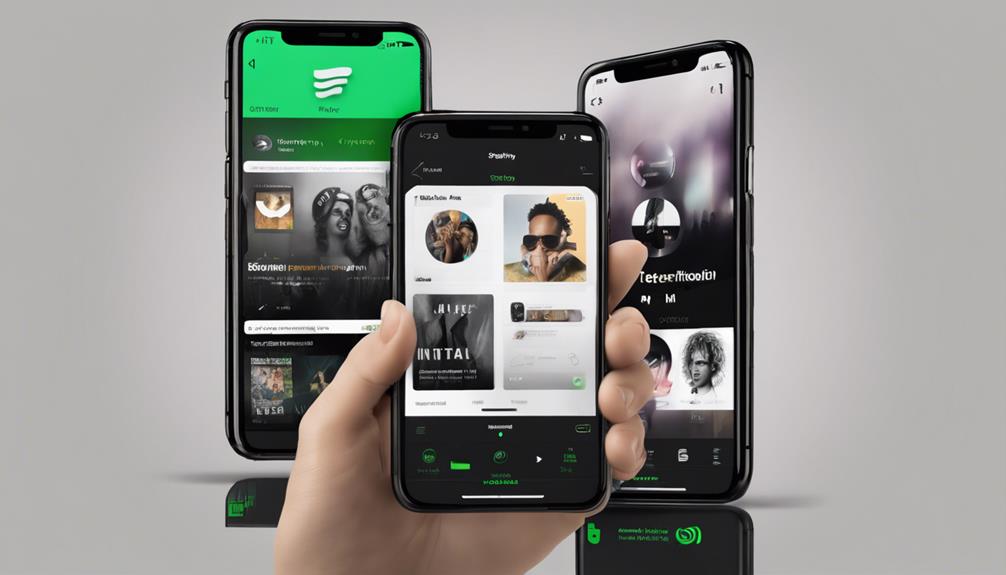
Moving from Spotify to Tidal smoothly involves key steps. Start by preparing Spotify playlists for transfer, take note of genres and artists. Utilize TuneMyMusic or Soundiiz for effortless transfer. Check internet speed and guarantee stable connectivity. Evaluate storage space for high-quality Tidal audio. Begin migration, select songs, convert with Tidal Music Converter. Confirm transfer success on Tidal. Explore Tidal's exclusive content and HiFi audio for a premium experience. Access artist-curated playlists and HD music videos. Tidal offers over 70 million tracks and exclusive content. Discover the detailed steps for a seamless switch to Tidal.
Key Takeaways
- Review Spotify playlists for transfer to TIDAL, noting genres and artists.
- Utilize playlist transfer tools like TuneMyMusic for seamless migration.
- Check internet speed for a smooth transfer process.
- Ensure enough storage space for TIDAL's high-quality audio.
- Verify successful transfer by comparing playlists and content.
Prepare Your Spotify Playlist Selection
Let's review our Spotify playlists to decide which ones we want to transfer to TIDAL. As we make this shift, it's vital to take into account the curated playlists, tracks, and exclusive content that we enjoy on Spotify.
Take note of the genres and artists present in each playlist to guarantee a smooth transfer process to TIDAL. Bear in mind that some exclusive Spotify content or tracks may not be available on TIDAL, so it's important to be mindful of any potential differences.
If you've customized your playlists or made specific edits, make a record of these for future reference.
Explore Playlist Transfer Tools

To effectively shift your Spotify playlists to TIDAL, explore different playlist transfer tools available to streamline the process and guarantee a smooth experience. Three notable tools for this task include TuneMyMusic, Soundiiz, and TuneCable Spotify Music Downloader.
| Playlist Transfer Tools | Key Features | Benefits |
|---|---|---|
| TuneMyMusic | Allows seamless transfer from Spotify to TIDAL, with the ability to select specific songs for transfer. | Easy customization of playlists during transfer. |
| Soundiiz | Streamlines playlist transfer between Spotify and TIDAL, providing real-time progress tracking. | Ensures visibility and control throughout the transfer process. |
| TuneCable Spotify Music Downloader | Enables downloading Spotify playlists for offline listening and subsequent transfer to TIDAL, retaining ID3 tags and offering various output formats. | Facilitates offline listening and maintains music data integrity during the transfer. |
These tools simplify the playlist transfer process, making it efficient and reliable while ensuring a seamless shift for your offline listening needs.
Ensure Stable Internet Connection

Ensuring a stable internet connection is key to a smooth shift when switching from Spotify to TIDAL.
To begin, check your internet speed to guarantee it meets the requirements for transferring music content.
If any connectivity issues arise, troubleshoot them promptly to prevent disruptions during the migration process.
Check Internet Speed
Regularly monitoring your internet speed is vital to guarantee a stable connection for a seamless migration of music from Spotify to TIDAL. When considering the shift of music, especially when you want to transfer Spotify playlists to TIDAL or download Spotify music in a lossless format, a reliable internet connection is essential.
By checking your internet speed, you can make certain that the online transfer process occurs without interruptions or delays. Opting for a high-speed connection will facilitate the quick and efficient transfer of your favorite tracks and playlists.
Prioritizing a robust internet connection is key to enjoying a smooth changeover between music streaming services, preventing any potential hiccups during the transfer process.
Troubleshoot Connectivity Issues
We recommend testing your internet connection speed to troubleshoot any connectivity issues affecting the transfer process. If you're facing connectivity issues, consider using a wired connection for better reliability. Additionally, restarting your router or modem can help troubleshoot any network problems that may be hindering the transfer. To optimize your connection, try to avoid peak hours of internet usage. If problems persist, don't hesitate to contact your internet service provider for further assistance.
| Troubleshooting Steps | Description |
|---|---|
| Test Internet Speed | Check your connection speed for stability |
| Use Wired Connection | Opt for reliability over wireless |
| Restart Router | Troubleshoot network problems |
Check Sufficient Storage Space
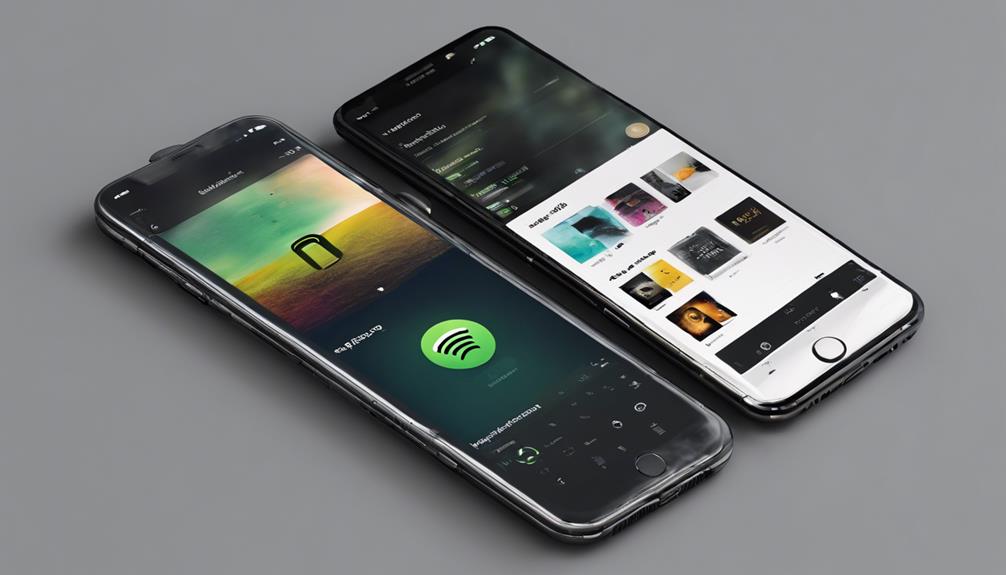
Before making the switch to TIDAL, it's important to evaluate the available storage space on your device to ensure peak performance with its high-quality audio files. TIDAL's lossless audio and HD music videos are known for their premium audio quality, but they come at a cost of requiring more storage than standard streaming services.
The high fidelity of TIDAL's audio, which is far superior to compressed audio formats, means that each song can take up more space on your device. Ensuring you have enough storage is vital for a seamless experience when moving from Spotify to TIDAL. By appraising the storage space beforehand, you can enjoy TIDAL's superior sound without compromises.
Make space for innovation by preparing your device for TIDAL's high-quality audio and embracing a new era of music streaming.
Begin Music Migration Process
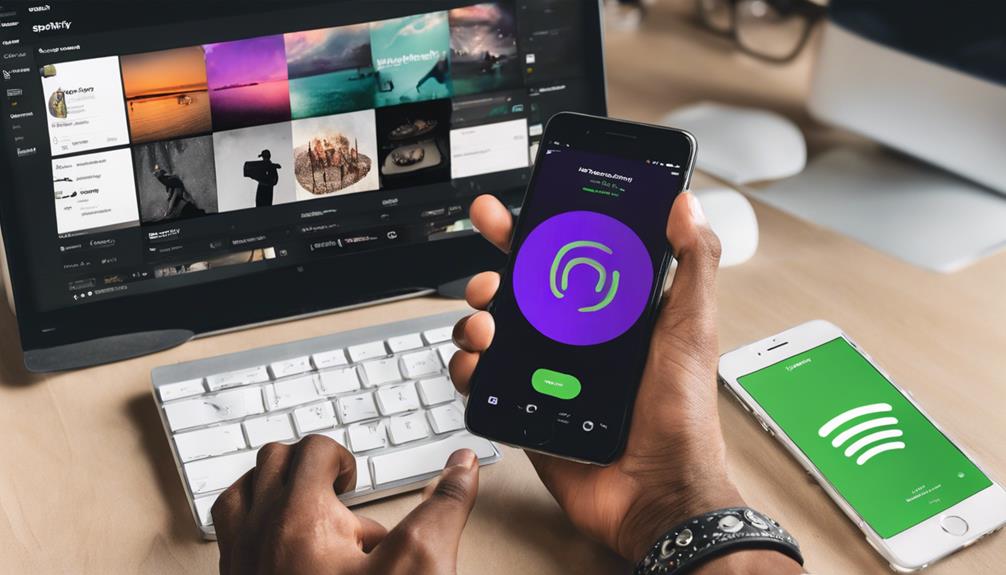
After evaluating your device's storage space, the next step is to smoothly initiate the music migration process from Spotify to TIDAL. To start moving your music, you can select specific songs or playlists from Spotify that you wish to transfer.
Utilize tools like TuneMyMusic or Soundiiz to seamlessly transfer playlists from Spotify to TIDAL. For offline listening, download Spotify playlists to your computer using TuneCable Spotify Music Downloader.
Once you have your selected music ready, it's time to convert and transfer them to TIDAL using a TIDAL Music Converter for enhanced flexibility. This process ensures that your favorite tunes make the shift with you.
Track your progress in real-time with Soundiiz to guarantee an efficient playlist transfer. By following these steps, you can smoothly convert and transfer your music from Spotify to TIDAL, allowing you to enjoy your playlists seamlessly on the new platform.
Verify Successful Transfer
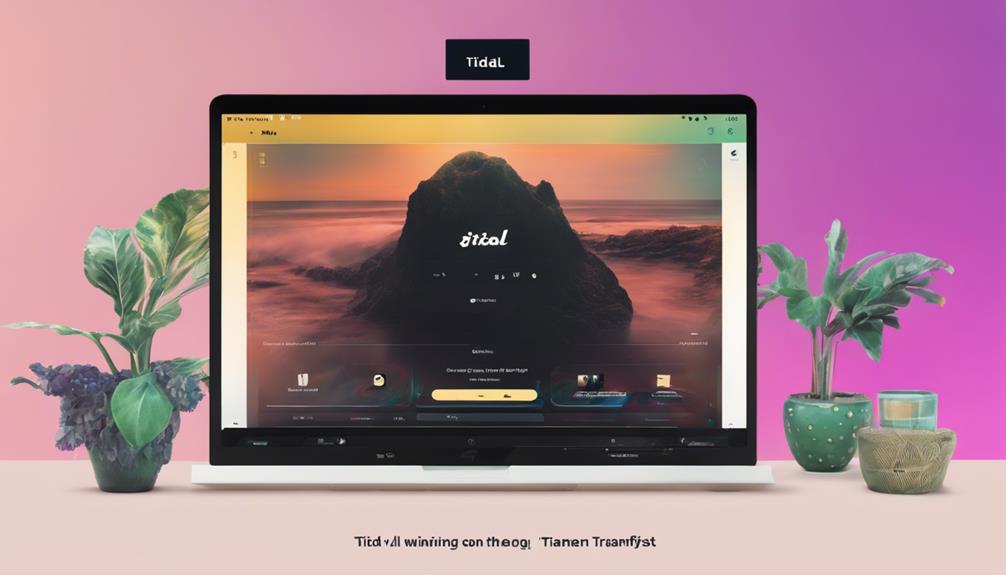
How can you guarantee that your switch from Spotify to TIDAL was successful? To verify the successful transfer of your music library, follow these steps:
- Check TIDAL Account: Download the TIDAL app and log in to your account to confirm that all your playlists, albums, and tracks from Spotify have been successfully transferred.
- Playlist Comparison: Validate that the playlist order and content match between Spotify and TIDAL after the transfer to guarantee a seamless switch.
- Artist and Music Migration: Ensure that all selected artists and their music migrated correctly to TIDAL, ensuring you have access to your favorite songs and albums.
Familiarize With TIDAL Features

Let's begin by exploring TIDAL's interface, where you can easily navigate through the platform's features.
Discovering exclusive content on TIDAL allows users to access music and videos not available on other streaming services.
Utilizing TIDAL's HiFi audio option guarantees a premium listening experience with superior sound quality.
Explore TIDAL's Interface
Exploring TIDAL's interface reveals a world of high-quality music experiences waiting to be discovered. TIDAL offers high-fidelity audio quality, providing a premium listening experience for music enthusiasts.
The platform features high-definition music videos that enhance your visual and auditory journey. Users can explore curated playlists tailored to various moods and genres, making it easy to find new music that resonates with their tastes.
TIDAL's interface is meticulously designed to cater to those seeking superior audio fidelity, ensuring an immersive and unparalleled music streaming experience. Whether it's exclusive content or an in-depth look into your favorite artists, TIDAL's interface offers a seamless and innovative way to enjoy music.
Discover Exclusive Content
Shifting our attention to familiarizing ourselves with TIDAL features, we can explore uncovering exclusive content available on the platform. TIDAL offers a range of exclusive content, including high-definition music videos and special features that enhance the music listening experience.
With its focus on lossless audio quality, TIDAL caters to music enthusiasts seeking premium music streaming services. The platform's curated content and special features provide users with a distinct music experience, attracting a global audience looking for a unique and high-quality music platform.
Utilize HiFi Audio
To make the most of TIDAL's audio quality, acquaint yourself with its HiFi and HiRes music options for an enhanced listening experience.
- Explore TIDAL's lossless audio quality for superior sound fidelity.
- Immerse yourself in TIDAL's HiFi and HiRes music features to enjoy excellent audio.
- Immerse yourself in high-quality audio files while streaming music on TIDAL.
Discover Exclusive Content
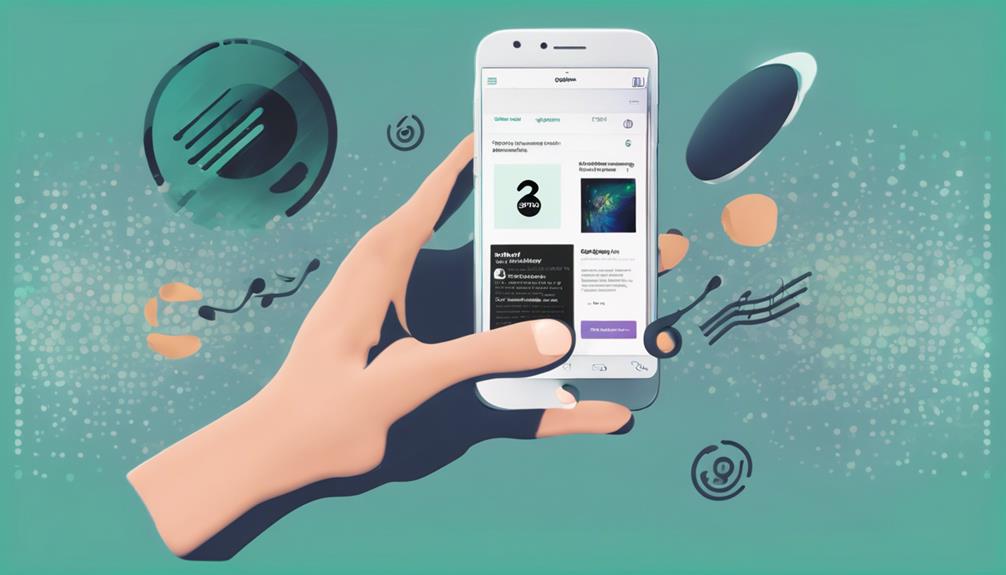
Accessing TIDAL reveals a treasure trove of exclusive music content, from engaging music videos to intimate artist interviews. TIDAL offers a unique experience by providing users with exclusive music releases, behind-the-scenes content, artist-curated playlists, high-quality music videos, and exclusive tracks.
Subscribers to TIDAL can enjoy special features such as live performances and exclusive concerts not found on other streaming platforms. By making the switch from Spotify to TIDAL, music enthusiasts can explore a world of content that goes beyond just listening to songs. Immerse yourself in a space where artists share their personal playlists, showcase exclusive performances, and offer a glimpse into their creative process.
Discover a whole new way to engage with music and artists through TIDAL's exclusive offerings, enhancing your music streaming experience with fresh and innovative content.
Enhance Music Streaming Experience
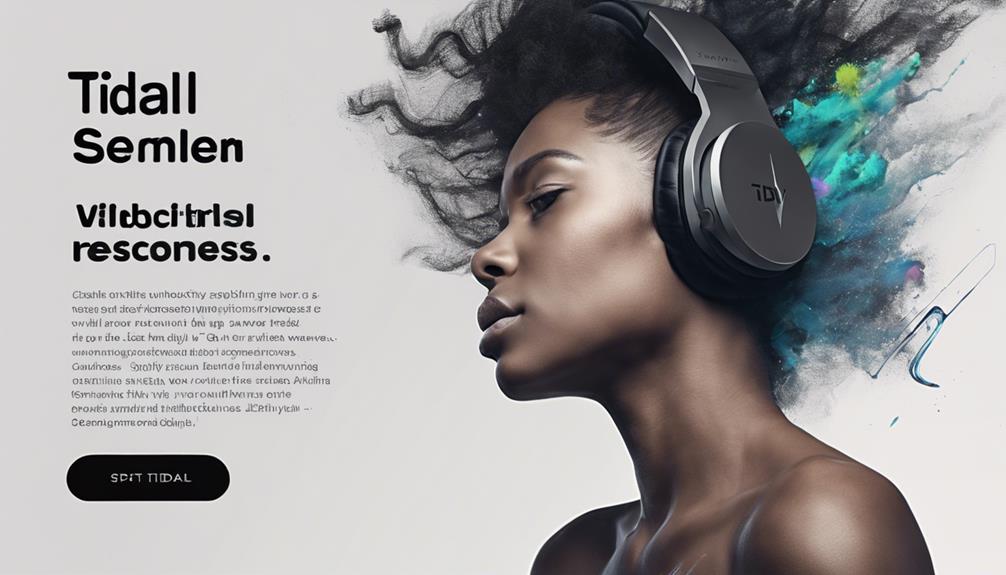
When considering how to enhance our music streaming experience, we must prioritize audio quality and access to exclusive content. TIDAL's offering of lossless audio and HD music videos sets the stage for a premium listening experience.
Audio Quality Comparison
Comparing the audio quality between Spotify and TIDAL reveals a noticeable difference in the music streaming experience. Here are some key points to keep in mind:
- TIDAL offers lossless HiFi and HiRes audio quality, appealing to audiophiles seeking excellent fidelity.
- Spotify provides up to 320kbps audio quality, while TIDAL focuses on high-quality streaming.
- TIDAL's emphasis on audio quality sets it apart from Spotify, making it a preferred choice for those who prioritize premium sound.
Understanding these distinctions can greatly enhance the shift from Spotify to TIDAL, providing a more immersive and high-fidelity listening experience for subscribers seeking top-tier audio quality.
Exclusive Content Access
Switching to TIDAL introduces users to a world of exclusive content that guarantees their music streaming experience. TIDAL offers high-quality, exclusive tracks, and access to a diverse library of music not found on other platforms.
Subscribers enjoy a premium experience with exclusive artist interviews, behind-the-scenes footage, and early album releases. TIDAL's exclusive content includes special playlists curated by renowned artists, setting it apart from other music streaming services.
Enjoy TIDAL's Music Collection
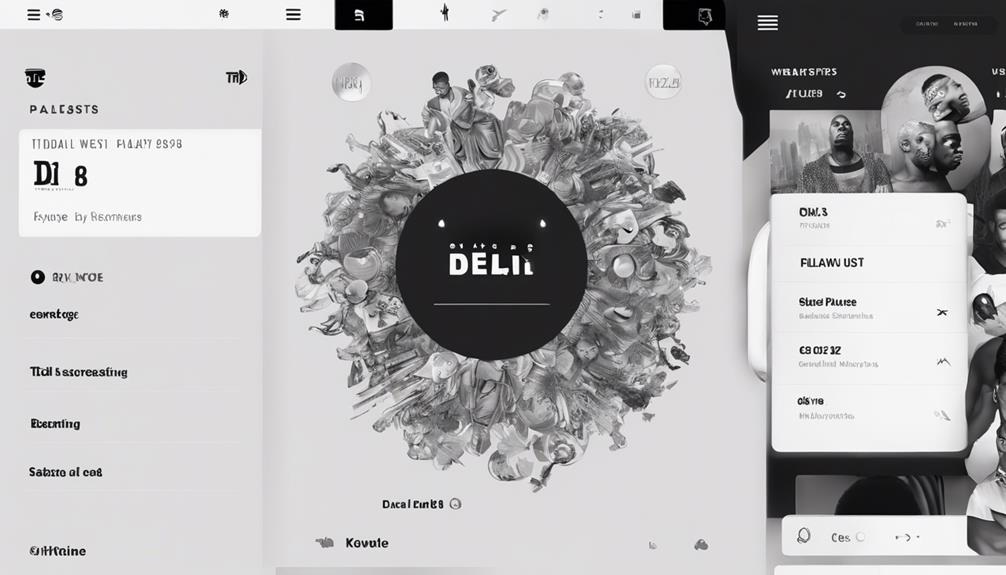
Exploring TIDAL's expansive music collection reveals a treasure trove of over 70 million tracks and 250,000 music videos for us to indulge in. TIDAL's curated playlists, artist radio, and personalized recommendations make discovering new music a breeze. The platform's lossless HiFi quality guarantees that every note is crisp and clear, providing a superior audio experience like never before. Additionally, TIDAL offers exclusive content, including live events and artist interviews, giving us unique insights into our favorite musicians and bands.
- TIDAL's curated playlists and artist radio enhance music discovery.
- The platform's lossless HiFi quality ensures superior audio experiences.
- Exclusive content like live events and artist interviews provide a deeper connection to the music world.
With TIDAL, offline listening, ad-free music, and high-definition music videos are just a subscription away, enriching our music streaming experience.
Frequently Asked Questions
How Do I Switch From Spotify to Tidal?
Switching from Spotify to Tidal is a simple process with online tools like TuneMyMusic or Soundiiz. Pick specific songs for a smooth switch.
Use tools like TuneCable Spotify Music Downloader to save playlists for offline listening on Tidal. Maintain audio quality and ID3 tags when converting Spotify music with TuneCable Tidal Music Converter.
Manage and enhance your Tidal music collection effortlessly.
Does Tidal Sound Better Than Spotify?
Yes, TIDAL indeed sounds better than Spotify. TIDAL's focus on high-quality streaming delivers superior sound, appealing to audiophiles seeking excellent fidelity.
The lossless HiFi and HiRes audio quality offered by TIDAL enhances the listening experience, setting it apart in the music industry.
Users appreciate TIDAL's premium sound quality, making it a top choice for those valuing exceptional audio performance.
How Do I Merge Spotify Playlists With Tidal?
To merge Spotify playlists with TIDAL, we recommend using online tools like Soundiiz or TuneMyMusic. These tools make it easy to transfer specific playlists from Spotify to TIDAL seamlessly. You can monitor the transfer progress in real-time.
How Do I Connect Tidal to Spotify?
To connect Tidal to Spotify, we recommend using online tools like Soundiiz or TuneMyMusic. These platforms facilitate a seamless transfer of playlists, albums, artists, and tracks between Spotify and Tidal.
Conclusion
To sum up, transitioning from Spotify to TIDAL can be a seamless journey with the right preparation and tools.
So, grab your favorite playlist, transfer it over, and explore TIDAL's exclusive content and enhanced features.
Before you know it, you'll be enjoying a whole new music streaming experience. Who knew changing platforms could be this easy and fun?
Happy listening!
AI Generator
Ownership Battle in the Age of AI-Generated Music

The emergence of artificial intelligence in music production has ushered in a new era of innovation. However, it has also sparked debates over ownership rights. As AI-generated music becomes more common, concerns about who owns these creations are brought to light.
This article delves into the legal battles and ethical debates surrounding AI-generated music ownership.
Defining Ownership in AI-Generated Music
In a traditional sense, determining the owner of the copyrighted material is straightforward. However, with AI-generated content, the situation becomes more complex.

Is the creator of the algorithm that generated the music the owner? Is it the person who trained the algorithm? Is it possible to claim ownership over something not directly created by human hands?
Grimes’s Controversial Tweet: A Case Study
Grimes’s tweet about allowing her voice to be used in AI-generated music exemplifies this issue. She said she would sell her digital soul for $10 million, granting an AI company permission to use her voice as they wished. The tweet sparked controversy, with some seeing it as selling out and others viewing it as a clever move.
Legal Battles and Intellectual Property
Ownership rights of AI-generated music are just starting to be tested in courts. In 2018, Sony won a landmark case against musician Kevin Parks Jr., who claimed he had created songs using Sony’s software without permission or compensation. The court ruled in favor of Sony since their software was used in creating Parks’ songs.
This ruling raises questions about whether algorithms can be considered intellectual property or merely tools used by creators. If algorithms are deemed intellectual property, there may be issues surrounding their licensing for commercial use.
Record Labels and the Changing Dynamics
As record labels adapt to the rise of AI-generated content, they, too, must confront ownership rights issues. Record labels have historically owned much of the copyright associated with artists’ work; however, this dynamic may change as more artists turn to AI-generated music.
If an artist uses an AI program to create a piece of music, who owns the rights to that work? Is it the artist or the creator of the algorithm that generated it?
Implications for Streaming Platforms
The rise of AI-generated music also impacts streaming platforms like Spotify and Apple Music. These platforms have already faced criticism for their low royalty payouts to artists, and if AI-generated content becomes more prevalent, this issue may only worsen.
Additionally, as record labels lose some control over ownership rights, they may push for higher payouts from these streaming services.
Public Domain and AI-Generated Music
The implications of AI-generated music on the public domain are worth considering. AI algorithms often use existing music data to create new compositions, raising questions about whether AI-generated music should be considered part of the public domain or if new legal frameworks are needed to protect both original creators and AI developers.
When an AI algorithm generates music based on existing works, it can be difficult to determine if the resulting composition is a derivative work or an entirely new creation. If AI-generated music is considered part of the public domain, it may limit the rights of original creators whose work was used as input. On the other hand, if AI-generated music is granted copyright protection, it could potentially stifle creativity and limit access to cultural works.
Moral Rights and AI-Generated Music
The concept of moral rights is particularly relevant in the context of AI-generated music. Moral rights protect an artist’s right to be recognized as the creator of their work and to preserve the integrity of their creations. It is important to discuss how moral rights might apply to AI-generated music and the potential challenges that may arise.
In the case of AI-generated music, it can be difficult to determine who should be recognized as the creator: the original artist whose work was used as input, the developer of the AI algorithm, or both. Additionally, AI-generated music may inadvertently modify or distort the original work, potentially violating the moral rights of the original creator.
AI-Generated Music and Fair Use
The concept of fair use plays a significant role in the context of AI-generated music. Fair use is a legal doctrine that allows for the limited use of copyrighted material without requiring permission from the rights holder. It is important to discuss whether AI-generated music, which often relies on existing music data, can be considered fair use and the potential legal implications that may arise.
When AI algorithms use existing music as input, they may be seen as transformative, creating new works based on the original material. However, the extent to which AI-generated music can be considered fair use is not yet clearly defined in the law, and it may vary depending on the degree of transformation and the potential market impact on the original work.
In conclusion, addressing the additional topics of public domain, moral rights, and fair use in AI-generated music contributes to a more comprehensive understanding of the various legal and ethical issues surrounding this emerging technology. As AI-generated music becomes more prevalent, it is crucial for legal frameworks and industry practices to adapt in order to balance the rights of creators, AI developers, and the public interest.
The Future of Ownership Rights
In conclusion, ownership rights in the era of AI-generated music are uncertain at best. As more legal battles arise and ethical debates continue, it is clear that traditional copyright laws will need to adapt to keep up with technological advancements.
The struggle for ownership is just beginning, but it will undoubtedly shape the future of the music industry for years to come.
AI Generator
The Influence of Artificial Intelligence on The Creation of Music

A New Era of Creativity and Expression
Music has always been a strong reflection of human innovation and emotions. Throughout history, our voices and musical instruments have played a crucial role in expressing our feelings, telling stories, and building relationships with others. As technology has advanced, our ways of creating music have also progressed.
Modern musicians now have access to various tools, enabling them to manipulate sound in unimaginable ways. Synthesizers can emulate virtually any sound, while digital audio workstations facilitate precise editing and manipulation of recorded tracks. And now, the rise of artificial intelligence (AI) offers musicians even more possibilities for music creation.
AI Applications in the Music Industry
AI is being utilized in multiple ways within the music industry. One popular application is generating original compositions based on existing musical data sets. By analyzing millions of songs across genres and periods, AI algorithms can identify patterns and generate new melodies or chord progressions that fit within those patterns.

Another application involves using AI to enhance existing performances or recordings. For instance, software like iZotope’s RX can isolate individual instrumental tracks from a mix and remove unwanted noise or artifacts without impacting the rest of the recording.
Unintended Consequences and Concerns
However, as with any emerging technology, unintended consequences arise from using AI in music creation. One worry is that AI-generated music might lack the emotional depth and nuance that human performance offers. While an algorithm can create technically proficient melodies or chord progressions, it may not capture the same sense of emotion or passion found in a live performance.
Another concern revolves around ownership rights of AI-generated music. If an algorithm generates an original composition based on data sets owned by multiple parties (such as record labels or streaming platforms), who has the rights to that composition? This question has already sparked legal battles between artists collaborating with AI algorithms and those claiming ownership over their contributions.
Harnessing AI for Collaboration and Growth
Many musicians and industry professionals see AI as an opportunity for collaboration and growth. AI can be a creative assistant, inspiring artists, helping them overcome writer’s block, or even offering suggestions to improve their compositions. As AI technology continues to evolve, its ability to learn from and adapt to a musician’s style will improve, further enhancing the creative process.
AI in Music Education and Talent Discovery
AI also has the potential to revolutionize music education and talent discovery. With AI-powered music learning apps and platforms, students can receive personalized instruction based on their skill level and learning style. Furthermore, AI can analyze and identify undiscovered talent by evaluating their performances and predicting their potential for success.

Addressing Ethical Considerations and Regulations
To ensure the responsible integration of AI into the music industry, it is essential to address ethical considerations and establish regulations. For instance, guidelines should be set to ensure that AI-generated compositions do not infringe on existing copyrights or that AI technology is not used maliciously to plagiarize or manipulate the work of others.
Additionally, as AI-generated music becomes more prevalent, it is crucial to develop clear standards for crediting the contributions of both human artists and AI algorithms to a given work. This will help to prevent legal disputes and foster a fair and transparent environment for all parties involved.
Ethical Considerations in AI-Generated Music
As AI-generated music becomes increasingly widespread, various ethical concerns emerge. Some of these concerns include the potential for AI-generated music to contribute to cultural appropriation, the dilution of traditional music styles, or the homogenization of music in general.
Cultural Appropriation
Cultural appropriation occurs when elements of one culture are adopted or used by members of another culture, often in a way that is disrespectful or exploitative.

AI-generated music, which often relies on large datasets of existing music, might inadvertently incorporate elements of various cultures without giving proper credit or understanding the cultural context. This can result in the misrepresentation or trivialization of the original culture and may lead to further marginalization of underrepresented communities.
Dilution of Traditional Music Styles
AI-generated music algorithms are often designed to identify popular patterns and trends within the music they analyze.
As a result, the output may lean heavily toward mainstream or widely-accepted styles, which can dilute traditional or less-popular music styles. Over time, this may result in a decline in the diversity of music genres and a loss of unique cultural expressions and heritage.
Homogenization of Music
The widespread use of AI-generated music could also contribute to the homogenization of music, as algorithms tend to create compositions based on patterns and trends found in existing data. This may result in technically proficient music lacking the distinctiveness and creativity found in human-generated compositions.
As AI-generated music becomes more prevalent, there is a risk that the rich tapestry of diverse musical styles and influences may be reduced to a more uniform, less imaginative landscape.
In conclusion, while AI-generated music offers exciting opportunities for innovation and new forms of creativity, addressing and considering the ethical implications of its widespread use is crucial. It is essential to develop ways to preserve cultural diversity and respect the heritage of various music styles while embracing the potential of AI in music creation.
Embracing the AI-Infused Future of Music
The increasing influence of AI in the music industry offers an exciting new frontier for creativity, collaboration, and innovation. By addressing the potential concerns and working together to create ethical guidelines and regulations, musicians, industry professionals, and AI developers can ensure that the integration of AI into the music landscape is both responsible and beneficial.
As we embrace this AI-infused future, we can look forward to new and innovative ways to create and enjoy music, while also remaining mindful of the potential pitfalls and challenges that come with any technological advancement. With the right approach, the future of music and AI has the potential to be a harmonious and groundbreaking partnership.
Despite these concerns, it’s undeniable that AI is revolutionizing the music industry in thrilling ways. It enables new forms of creativity and experimentation while also presenting unique challenges for artists and record labels alike. As we continue to navigate this new era of music creation, it will be fascinating to see how these unintended consequences evolve.
Podcast
Bridging the Gap: Harnessing the Power of Podcasts and Videos to Connect Communities with Vital Services

Podcasts and Videos in Community Services
Community support services are essential for helping those in need, but many individuals are unaware of the resources available to them. This is where podcasts and videos play a vital role as powerful tools for educating and engaging community members.
By creating audio and visual content that highlights the impact of community services, organizations can bridge the gap between service providers and the people they serve.
In this blog post, we will explore the various benefits of incorporating podcasts and videos into community services strategies and best practices for creating engaging content.
The Role of Podcasts and Videos in Strengthening Community Services
Podcasts and videos are a powerful way to communicate with community members and inform them of available services. Through audio and visual content, community service organizations can educate and engage their audience.
Podcasts and videos can help bridge the gap between community members and service providers, increasing accessibility and awareness of resources. Creating content that highlights the impact of community services can inspire others to get involved and support the cause.
Podcasts and videos can also provide a platform to share personal stories and experiences, helping to break down stigma and create a sense of community.
How Podcasts and Videos Can Help Improve Access to Community Resources
Podcasts and videos can provide a medium for sharing information about important community resources in an engaging and accessible way. This is particularly important for individuals who may not have access to traditional written materials or may have language barriers. Here are some ways in which podcasts and videos can improve the accessibility of community resources:
- Breaking down language barriers: Audio and visual content can help reach individuals who may speak a different language or have limited literacy skills. By providing information in a format that doesn’t rely on reading, podcasts and videos can help ensure that more members of the community are able to access important resources.
- Providing updates: Podcasts and videos can be used to provide updates on changes to community resources such as hours of operation, new programs, or changes to eligibility criteria.
- Encouraging action: Creating content that encourages community members to take action, such as accessing resources or volunteering, can help improve utilization of services. By highlighting the benefits of certain resources, podcasts and videos can help inspire individuals to take advantage of them.
- Showcasing impact: Podcasts and videos can showcase the impact of community resources through personal stories and testimonials, further highlighting their value. By sharing stories of those who have benefited from the resources, community service organizations can emphasize the importance of accessibility to community resources.
In short, podcasts and videos can play a crucial role in improving access to community resources by breaking down language barriers, providing updates, encouraging action, and showcasing impact.

Community service organizations should consider incorporating these mediums into their outreach efforts to help ensure that important resources are accessible to all members of the community.
The Benefits of Using Audio and Video Content in Community Outreach Programs
Using audio and visual content can have many benefits for community service organizations looking to reach a wider audience and strengthen their outreach efforts. Here are some of the key advantages:
- Engaging format: Audio and video content can be more engaging and memorable than written materials, helping to capture the attention of community members and inspire them to take action.
- Accessibility: Audio and visual content can help organizations reach individuals who may not have access to traditional written materials or who speak a different language.
- Personal connection: Incorporating personal stories and testimonials can help community members feel more connected to the cause and motivated to get involved.
- Establishing expertise: Creating regular content, such as a podcast or video series, can help organizations establish themselves as thought leaders in their field and build a following.
- Collaboration: Podcasts and videos can provide a platform for collaboration and partnerships with other organizations, further strengthening the impact of community outreach programs.
Overall, incorporating audio and video content into community outreach programs can help organizations better connect with their audience, improve access to important resources, and build a stronger, more engaged community.
Using Podcasts and Videos to Enhance Volunteer Recruitment in Community Services
Volunteers are a crucial part of any community service organization. However, finding and recruiting volunteers can be a challenge. Podcasts and videos can be an effective way to enhance volunteer recruitment efforts.
Creating Content that Highlights the Impact of Volunteer Work
One of the most powerful ways to inspire people to volunteer is by showcasing the impact that their work can have. Creating content that tells the stories of volunteers and the impact they’ve had can be a powerful recruitment tool.
Consider producing videos or podcasts that feature interviews with volunteers, sharing their experiences and the change they are making in their communities. Highlighting impactful volunteer projects that have made a difference in the community can also be a great way to draw attention to volunteer opportunities.
Providing Information on Volunteer Opportunities
Podcasts and videos can also be used to provide information about volunteer opportunities. Creating a series of short videos or podcast episodes that highlight different volunteer roles and the skills needed to excel in them can be a great way to engage potential volunteers.
It can also be helpful to include information on the benefits of volunteering, such as gaining new skills, meeting new people, and making a positive impact in the community. By sharing this information in an engaging and accessible format, community service organizations can attract more volunteers and build a strong team of supporters.
Using Storytelling to Encourage Volunteer Action
Storytelling can be a powerful tool for encouraging people to take action. By sharing stories of the impact that volunteers have had in the community, organizations can inspire others to get involved.
Consider using video or audio content to showcase the experiences of volunteers and highlight the difference they have made. Encouraging existing volunteers to share their stories and experiences can also be an effective way to generate interest in volunteering and attract new supporters.
By incorporating podcasts and videos into their outreach strategies, community service organizations can enhance volunteer recruitment efforts and attract more supporters. Whether through highlighting the impact of volunteer work, providing information on volunteer opportunities, or using storytelling to encourage volunteer action, audio and visual content can be a powerful way to engage and inspire others to get involved in their communities.
Creating Engaging Video and Audio Content for Community Service Organizations
When it comes to creating content for community service organizations, it’s important to consider the audience and their preferences for consuming information. Here are some tips for creating engaging video and audio content:
- Incorporate personal stories and testimonials: By sharing personal stories of how the organization has made a difference in people’s lives, you can make the content more relatable and engaging for viewers and listeners. Testimonials can also help build credibility for the organization.
- Use visual aids: Visual aids, such as infographics, images, or animations, can help simplify complex information and make it more accessible. Consider using visual aids to break up the content and emphasize important points.
- Create a consistent style and format: Creating a consistent style and format can help build a recognizable brand and increase engagement with regular viewers and listeners. Consider using the same intro and outro music, or using the same colors and fonts throughout your content.
- Experiment with different types of content: To keep your audience engaged, consider experimenting with different types of content, such as short videos, interviews, or animations. By mixing up the format, you can keep your content fresh and interesting.
By following these tips, you can create engaging video and audio content that will help your organization connect with your audience and increase awareness of your services.
Best Practices for Incorporating Podcasts and Videos into your Community Services Strategy
Identify clear goals and objectives
Before incorporating podcasts and videos into your community services strategy, it’s important to identify clear goals and objectives. Consider what you hope to achieve through this type of content and the audience you want to reach. This will help guide your content creation and ensure that your efforts are aligned with your overall strategy.
Invest in high quality equipment and editing software
Investing in high quality equipment and editing software is essential to ensure that your content is professional and engaging. This doesn’t mean that you have to break the bank, but it’s important to have equipment that can produce high quality audio and video content.
Designate a team or individual responsible for content creation
To ensure that your content is published on a consistent basis, designate a team or individual responsible for content creation. This person should have experience with audio and video production, as well as a strong understanding of your organization’s mission and goals.
Engage with the audience through social media and other channels
Engaging with your audience through social media and other channels is key to building a following and encouraging feedback and participation. Monitor comments and respond to questions or concerns promptly to create a sense of community and encourage ongoing engagement.
Measure impact through metrics
Finally, measure the impact of your podcasts and videos through metrics such as downloads, views, and engagement to continuously improve and refine your strategy. This will help you identify what’s working and what’s not, and make data-driven decisions on how to improve your content and reach your goals.
Note: Remember to always prioritize the needs and preferences of your audience when creating content for your community services strategy. By understanding what they want and need, you can create content that resonates with them and helps build a stronger connection between your organization and the community.
Conclusion
In conclusion, podcasts and videos can be powerful tools for community service organizations to communicate with their audience and share important information about available resources. By creating engaging and informative content, these organizations can reach a wider audience and inspire individuals to get involved and support their cause. Incorporating personal stories, testimonials, and visual aids can help create a sense of community and build brand recognition.
Best practices include identifying clear goals, investing in quality equipment and software, designating a team or individual for content creation, engaging with the audience, and measuring impact for continuous improvement.
Using podcasts and videos, community service organizations can strengthen their outreach efforts and make a meaningful impact on their community.
-

 Vetted2 months ago
Vetted2 months ago11 Best Gore Websites to Explore the Darker Side of the Internet
-

 Music Theory2 weeks ago
Music Theory2 weeks agoUnlocking Nature’s Harmony: The Power of 432 Hz Frequency in Sound & Music for Enhanced Living and Well-Being
-

 Vetted1 month ago
Vetted1 month ago15 Best Commercial Vacuum Cleaners for Heavy-Duty Cleaning Jobs
-

 Vetted2 months ago
Vetted2 months ago15 Best Essential Oils Brands to Elevate Your Aromatherapy Experience
-

 Sound Design2 weeks ago
Sound Design2 weeks agoWhat Is the Difference Between a Sound Engineer and A Sound Designer?
-

 Native Instruments Kontakt2 weeks ago
Native Instruments Kontakt2 weeks agoVOCAL AI – Animated Intelligence: The Ultimate Vocal Playground
-

 Sound Design2 weeks ago
Sound Design2 weeks agoWhy Sound Engineer
-

 Vetted2 months ago
Vetted2 months ago15 Best Concrete Sealers for Ultimate Protection and Longevity








